Photo
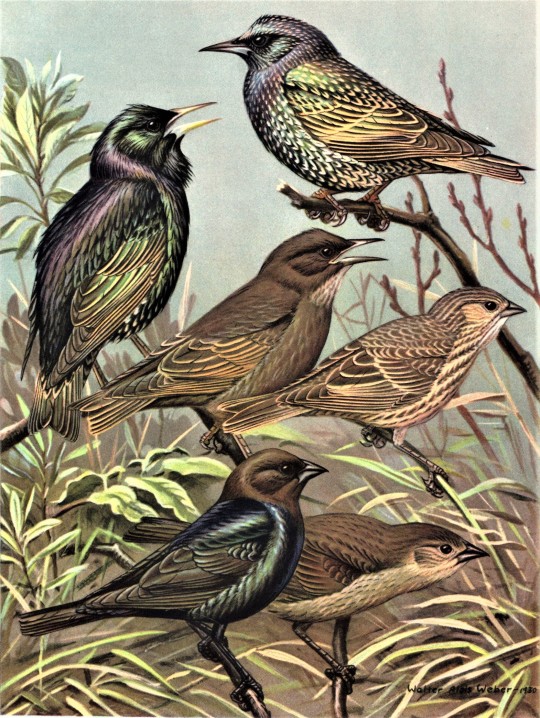
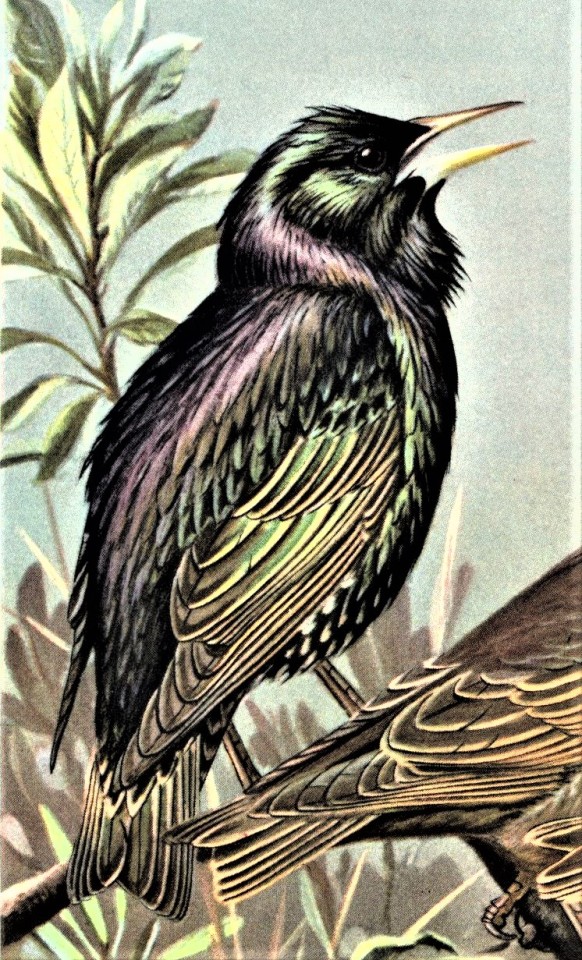

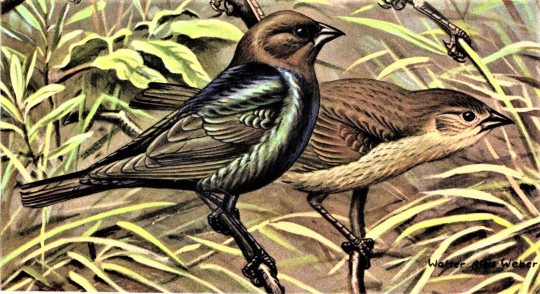
A Starling and Cowbird Feathursday
The Starling (Sturnus vulgaris) and the Brown-headed Cowbird (Molothrus ater) are sometimes considered “problem” birds. The Common Starling, which in America is an invasive species, is brash, aggressive, and prolific, and can have a negative impact on native bird populations.
The Brown-headed Cowbird does not raise its own brood but rather parasitizes the nests of smaller birds, often to the detriment of the host’s own brood. Very sneaky. On top of that, Cowbirds periodically check on their eggs and young, and if the parasitic egg has been removed, the Cowbird will engage in retaliatory actions known as “mafia behavior” by ransacking and sometimes completely destroying the host’s nest. Just nasty.
Despite the boorish behavior of both species, we just can’t help being delighted when we see them, especially adult male Starlings during breeding season, with their iridescent purples and greens and their long strings of melodic, mechanical, and even liquidly-sounding calls. The image shown here is a reproduction of a 1930 painting by American nature artist Walter Alois Weber from Bird Portraits in Color by the American physician and ornithologist Thomas Sadler Roberts and published by the University of Minnesota Press in the 1934.
The birds at top of the painting are a young male Starling (right) and a breeding adult male; at center, a juvenile Starling and a juvenile Cowbird; at bottom, adult male and female Cowbirds.
View other posts from Bird Portraits in Color.
View more Feathursday posts.
5K notes
·
View notes
Text
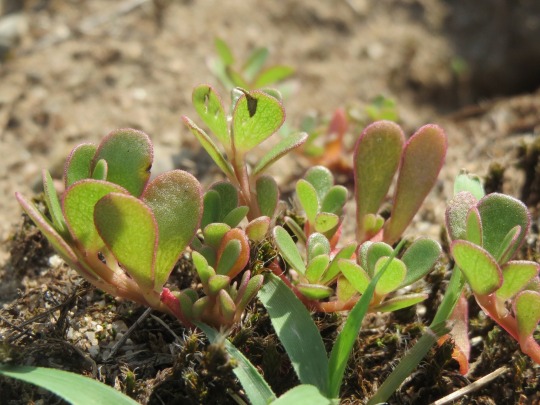

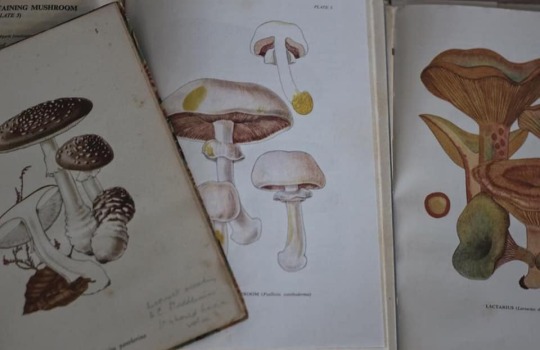
There are literally loads of food all around us, in the forms of mushrooms, berries, herbs, leafy greens, roots, and more, hiding in plain sight or in places you'd least expect. Tapping into the ancient practice of foraging is something we love - not only does it open up a whole new world of local food, but it also brings us closer to nature and to what we are eating. Just remember to be 1000% sure you know what it is that you are eating!
Check out Justin David Williams's recently launched online website. It's a great way to get started:
www.foraging.co.za
For more great resources, join the Foraging - South Africa Facebook group.
#foraging#forage#mushrooms#mycology#wild food#mushroom#mushroom hunting#wild mushrooms#indigenous food#local food#mushroom foraging#mushroom friends#south africa
2 notes
·
View notes
Photo

“Rot at the Root” by Molly Costello
Artist’s description:
“A vertical black and white digital illustration depicts a figure with long hair, a short sleeve button up jumpsuit and high heel boots yanking up a thorny vine. This vine with circular leaves twists around the figure as they try to uproot it. It’s flowers have skull faces in their center. The vines roots grow out of two US dollar bills. One bill face has a white klan hood and says SUPREMACY. The second bill has a skull face and says CAPITALISM. From the bottom right where the vine is not growing, there are healthy plants and small pollinators coming in to fill the space.”
#green anarchism#anarchism#anarchy#green anarchy#green#envrionmentalism#environmental activism#environmental activis#environmental art#anarchist art#anti-capitalism#struggle#revolution#rebellion#solidarity#mutual aid#decentralization
45 notes
·
View notes
Photo

The Glasswinged Butterfly
Today’s lovely lepidopteran is a member of the brush-footed family called Greta oto, or the glasswinged butterfly. It is named after its uniquely transparent wings, which give it the advantage of camouflage without any extensive coloration. This butterfly fits in wherever it goes! In Spanish speaking countries, this butterfly is sometimes known as espejitos, or “little mirrors”. Its glass-like wings may evoke an air of fragility, but this dainty-looking creature is actually capable of carrying up to forty times its own weight and it has been known to make long migrations. The glasswinged butterfly is typically found in Central and South America, and thrives in tropical rainforest conditions.
Image Source: David Tiller. August 30th, 2008. Wikimedia Commons.
559 notes
·
View notes
Photo
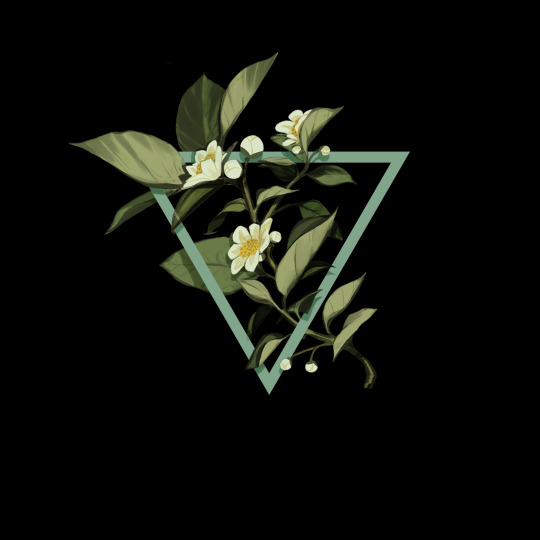


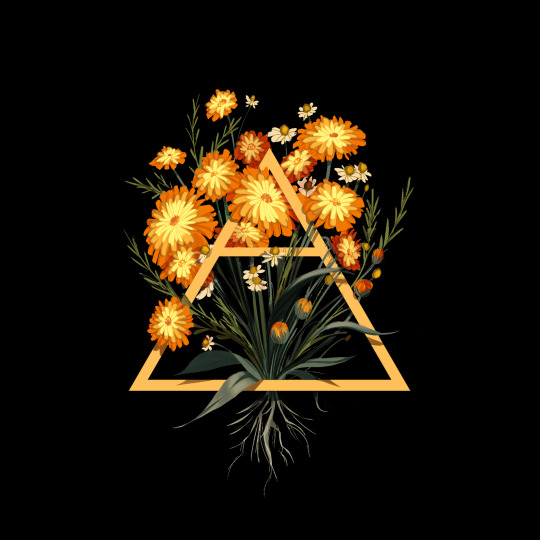
tea elements
green tea - water
rose rooibos - fire
lavender earl grey - earth
chamomile calendula - air
101K notes
·
View notes
Photo



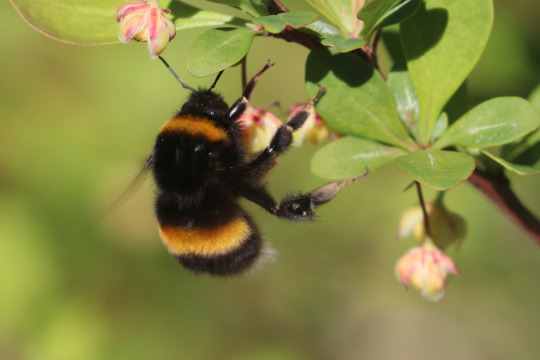
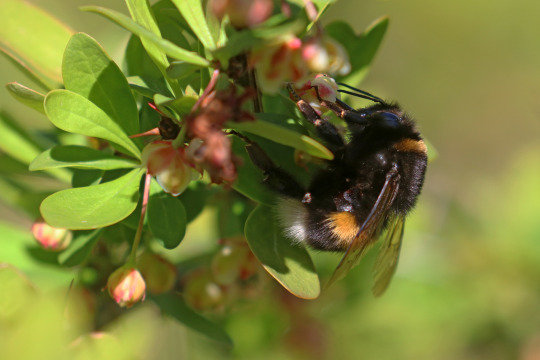

The bumblebees really like our Japanese barberry.
64K notes
·
View notes
Text
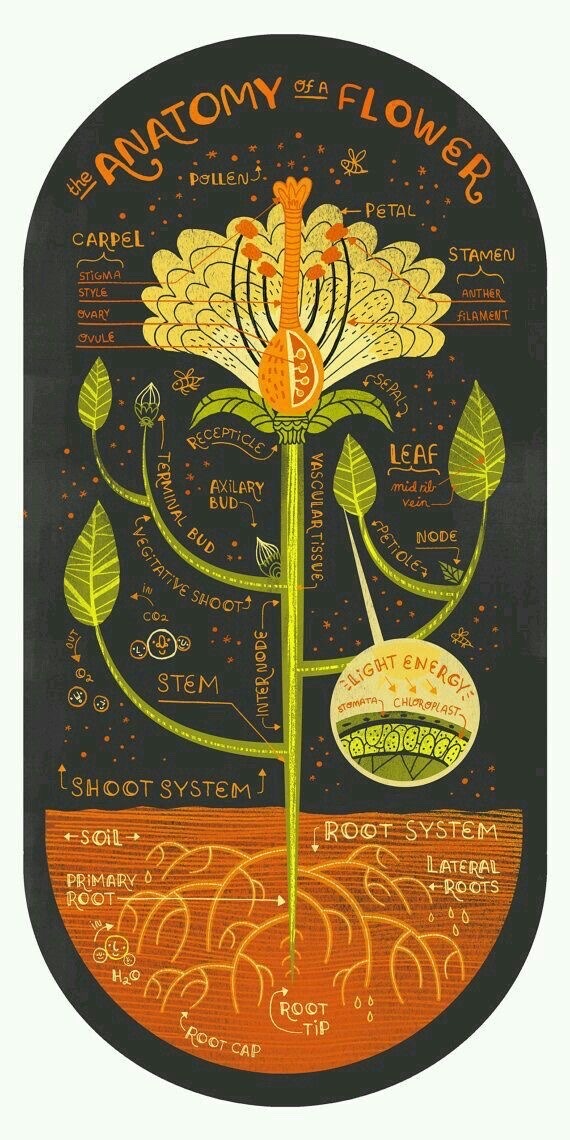
Such a lovely overview of a flower’s anatomy.
Illustration by Rachel Ignotofsky
#flower#plant#anatomy#biology#cross section#botany#botanical#blossom#agriculture#farming#regenerative agriculture#permaculture#regenerative farming#plant love#plant lovers#nature#pollen#love nature#ecolovers#go green#green anarchism#green anarchy#illustration#diagram#poster#art
442 notes
·
View notes
Text
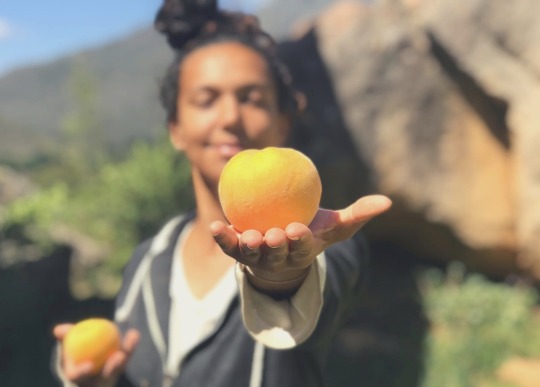
First peach harvest of the season!
Although the quantities are somewhat lower than recent years, thanks to a seriously late winter, our organic tree-ripened yellow cling peaches taste as incredible and as juicy as ever.
Photo by us, Those Who Harvest
#peach#orchard#fruit farming#fruit growing#grow it yourself#our harvest#harvest#organic fruit#stone fruit#farm life#natural farming#farming#permaculture#regenerative agriculture#regenerative farming#agriculture#sustainability#organic farming#those who harvest#eat organic#farmers#fruit trees#life is a peach#peachy#freshly picked#chemical free#juicy
2 notes
·
View notes
Text

Remember to love the soil.
We always try to follow the basic tenets of farming naturally:
• shield - the soil from light and heat by growing plants and/or using mulch
• do not disturb! let it be, and try to plough / till / dig or churn it as little as possible
• diversify - the bigger the variety of plant, fungi and bacterial life in the soil, the better the biology will function
Artwork by Molly Costello.
#molly costello#farming#regenerative agriculture#regenerative farming#agriculture#permaculture#sustainability#organic farming#natural farming#soil health#kiss the ground#love the earth#soil#soil biology#world soil day#dirt to soil#grow with nature#biodiversity#art#poster#lino#green anarchism#green anarchy#farmers#anarchism#environmentalism#ecofriendly#ecowarrior
359 notes
·
View notes
Text

Some intensive companion and inter-planting inspiration! This is how things should be grown - flowers inbetween to attract beneficial insects, diversity to encourage soil health, and close plant spacing to breed resilience.
(Image source unknown)
#farming#regenerative agriculture#regenerative farming#agriculture#gardening#permaculture#sustainability#organic farming#intercropping#companion planting#vegetable growing#vegetable gardening#grow it yourself#natural farming#how it’s grown#biodiversity#multicrop#polycrop#lowtech
209 notes
·
View notes
Photo

Conventional Monoculture VS Holistic Polyculture
Illustration by Vincent Mahé, for the book “Demain”, by Cyril Dion and Mélanie Laurent
#polyculture#agriculture#holistic agriculture#regenerative agriculture#regenerative farming#farming#permaculture#sustainability#ecofriendly#natural farming#art#cartoon#comic#poster#vincent mahe#demain#cyril dion#melanie laurent
572 notes
·
View notes
Text
COMMON TOMATO PLANT AILMENTS
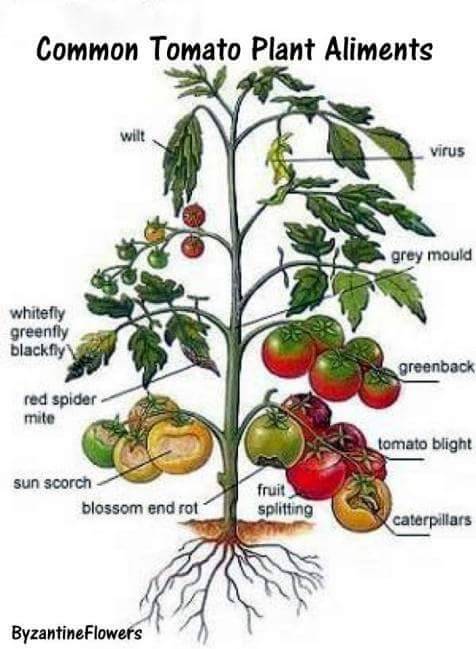
Growing fresh tomatoes is one of the true joys of the vegetable gardener. But tomatoes can suffer from all kinds of diseases and pests. Causes often are related to weather conditions, which of course can’t be controlled. However, if you know your area is prone to a certain disease, you should look for varieties that are listed as resistant
Keep reading
116 notes
·
View notes
Photo

How to Build Your Own Living Structures by Ken Isaacs, 1974.
4K notes
·
View notes
Text
Self-Sufficiency in the Time of Pandemic
With the current path that we as a planet are on, the facts are becoming increasingly obvious: times are going to get tough, in many ways. Climate Change warning flags, such as rising temperatures, more numerous and intense natural disasters and struggling ecosystems; and problems particular to the human population, such as resource depletion and the current COVID-19 outbreak we are currently facing; make it pretty clear that from here on out, humankind needs to be resourceful in order to survive.
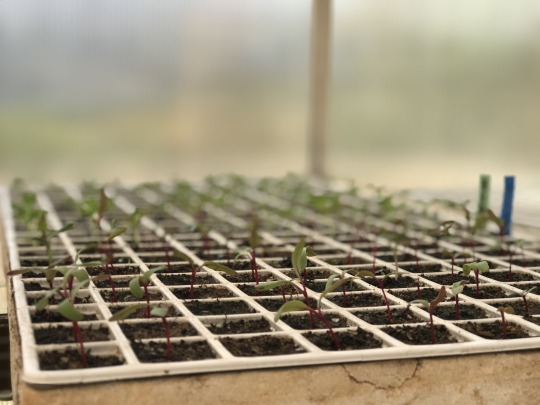
We are busy going through something unprecedented in human history – there have been pandemics and widespread outbreaks before, but never has the world seen such a huge human population, nevermind one which is so interlinked across the globe. When you think about it, getting anxious during these times is only a natural and somewhat necessary response. But once one’s head begins to clear and the reality of the global situation sets in, the important questions begin to emerge: How am I going to look after myself and those I care about?
The measures we should all be taking to “flatten the curve” and slow the spread of the virus in time for healthcare systems to cope – physical distancing, washing our hands, and isolation, are all symptomatic responses to the current crisis. Don’t get me wrong, they are extremely important to how the pandemic unfolds, but I believe we should also be looking further down the line into the future. The world as we know it is changing before our very eyes, at a pace which is frighteningly tangible, and this pandemic is showing us a few key points, which can now no longer be denied:
We live in a global society – whether we like it, or not. This means that we ultimately need to work together, and respect our place in the collective human species, taking the rights of others to heart.
We are painfully dependent on ageing systems which are designed with profit as the key component, not necessarily human or planet welfare. Capitalism has engulfed all spheres of our society, to the point where the very things we need in order to survive – food, water, shelter and medicine, are turned into mechanisms through which we, as “consumers” can be drained for financial gain.
Our international leadership is largely inadequate and, whether on purpose or due to bureaucratic red tape, slow to act and respond in our time of need. Many countries have seen their governments refuse to react to the pandemic sufficiently, meaning that it wasn’t contained when it should and could have been, and as a result things have gotten much worse.
There are good (as in, really really good) everyday people out there who are willing to put their lives at risk to help others. Cashiers, paramedics, janitors, farmers, teachers, doctors, nurses, and many other overlooked professions are in fact the real heroes in this situation – and not the CEOs, directors or owners of companies. Without those who keep our society running through the day-to-day necessities, things would begin to crumble real fast.
Pandemics can affect everyone, regardless of their demographic. whether directly or indirectly, when something like this happens, it affects you – regardless of who you are. Stock markets and currencies are beginning to crash, companies are closing down, borders have been shut, and lockdowns are taking place. Things like these have far-reaching effects, which can be felt everywhere.
That being said, the planet can feel them too – just a few weeks of decreased human activity can lead to huge environmental improvements such as less pollution, returning wildlife and cleaner waters. This is just a little “sneak peak” at what is possible if we change our ways and try to live more harmoniously with nature.
Once this particular chapter of history subsides, how do we protect ourselves – personally, and on communal and global levels from similar things in the future? Ultimately, they are unavoidable and bound to happen again, be it in a different way or form. Once we accept that there are elements we cannot control, we can begin to look at what can be done to minimise our own suffering, and that of those in the same boat as us, at the hands of such disasters.
Look After Yourself:
Strengthen That Immune System
This virus might subside, but chances are that it will be back, or another will take its place soon enough. So you need to fortify your body’s natural defences in order to give them the best chance of fending off such things. This boils down to one thing: keep healthy. Organic fruit and vegetables bring none of the poisons or chemicals that conventional produce carry with them, and often contain more vitamins and antioxidants. In particular, things like garlic, chillies, ginger, broccoli and citrus fruit are great turbo-chargers of the immune system. The fresher your food, the more nutrients it contains, and the better it is for you – so avoid canned or prepackaged produce where possible.
Local is Lekker
In South Africa, we have a saying that “Local is Lekker” – it essentially means that what comes from nearby is great; and it couldn’t be more on point or relevant than right now. By choosing things from local suppliers, businesses, farms, and organisations, you are not only decreasing reliance on the transportation system, but also “voting” with your coin against multinational corporations. Of course, the more local you can get, the better – ultimately, you should aim to be growing as much of your own food as possible. For some, this may mean growing a basil plant on their balcony, for others, perhaps a bed of tomatoes and garlic in their garden. Do what you can, with what you have. We recently began offering food garden design, consultation and establishing services, so if you are interested, please do contact us. Otherwise, support your local farmer and get to know where your food is coming from – it is a great step in not only learning how it’s grown, but also in becoming aware of what you are eating and how it reaches you. We deliver weekly boxes of our fresh organic produce to people nearby every week. Read more about or boxes, or order here.
Water is Life
Without water, we’re in trouble – just ask any Capetonian about the struggle. Having narrowly missed day zero, we can all attest to the importance of this liquid in our lives. Ensuring that you have a good supply or reserve of clean, drinkable water is of utmost importance. Setting up rainwater and dew harvesting can be done extremely easily and fairly cheaply – whether using small tanks to catch rainwater from gutters, catching your bathing water to water your garden.
Take Shelter
If you are among the lucky who have a good roof over their heads, take a moment to appreciate it, and consider how you can improve your dwelling. If there were to be a nearby disaster such as a flood or fire, how would it hold up, or perhaps instead, what is the contingency plan? If you are looking to set up a home somewhere, how can you construct it in such a way that it requires as little new resources as possible, and makes use of what is around? Small changes, such as using natural building materials, simple designs or even just taking note of the prevailing wind can have rather big impacts on a home, and are often overlooked.
Avoid Blackout
Technology plays a huge role in our lives – beyond communication and business, we rely on it to keep our food cold, light up our homes, drive our vehicles and make our stuff. All it takes is a little “Stage 2 Load-shedding” from your friendly neighbourhood power supplier to remind you how dependent we are on it. Although going entirely off-grid is becoming cheaper at a rapid rate, it is still largely out of the financial question for most people. But that doesn’t mean that you can’t take certain smaller measures in order to reduce your reliance on the grid. Depending on your financial position, you can take various steps – install a solar geyser to get electricity-free hot water on tap, buy or make simple solar lamps to light up your house (it’s really easy – look it up), sell your fridge and replace it with a gas alternative, or even just put together a little solar oven (we made one out of an old window and some planks – it cooks brownies like a charm!).
Wash Your Hands
Keeping things clean is a must. But don’t let that fool you into thinking that stockpiling toilet paper and hand sanitiser is necessary. Firstly, that just creates a shortage (do you see the self-fulfilling prophecy here?) and secondly, if worst came to worst and all the toilet paper in the world were to run out, you could use water like the entire continent of Asia is still largely doing after centuries). What is important is finding a way to maintain good hygiene and prevent illnesses from coming into your home and body. The good news is that soap, hand sanitiser, shampoo, and even general house cleaners are really easy to make with very simple, cheap and biodegradable ingredients. Good friends of ours, Guerrilla House, hold frequent soap-making workshops in Cape Town, and there is a plethora of online resources which can teach you how it’s done.
All these steps, however small they may be, add up and create a ripple effect, which although may seem immeasurable, can grow into a huge wave, given the right tide. So my advice is this: prepare yourself. Don’t freak out about the toilet paper, and don’t panic in general. But take time to think about how you can reduce not only your financial and environmental footprints, but also your reliance and dependence on the systems that surround you. And when you do need to depend on them, do it consciously and with full understanding and awareness of the implications it has. Be selective about how you “vote” with your spending – support those near to you, both geographically and socially speaking, and in so doing help build the network of interdependence we all need in order to survive. Because if the governments of the world aren’t going to look after all of us, then we will do it ourselves.
– Nevau, one of those who harvest
#self sufficiency#self sufficent#self sufficient living#self reliance#self reliant#independence#off-grid#prepper#doomsday preppers#pandemic#coronavirus#covid-19#ThoseWhoHarvest#those who harvest#diy#organic farming#eat organic#grow organic#seedlings#seed tray#germination
4 notes
·
View notes
Text
Featured Movie — The Biggest Little Farm
It’s not very often that a movie is beautifully shot, truly entertaining, and educational. But The Biggest Little Farm, filmed, written, produced by and featuring John Chester, along with his wife Molly, on their true life adventure from city slickers to full-on regenerative farmers, somehow is all of those. Technically, one could classify it as a documentary as it follows their real story and is actual footage, but that doesn’t mean one should. To do so would be to reduce it down to the facts it contains. It is much more than just an informative piece — it is a delightful, inspiring tale of human perseverance in the face of curveball after curveball, an example of the essence of farming.

For me, as somewhat of a cinephile, the film is so immersive that one can’t help but be drawn in, and relate to the Chesters’ story. John, previously a wildlife filmmaker for the likes of Animal Planet, clearly has an undeniable talent for capturing the incredible intricacies of fleeting moments in nature, and translates their journey into a visual feast. To be quite honest, the fact that he was able to capture the footage while also going through what they did during the course of the film is commendable to say the least.
For me, as a farmer, the film serves as a heartwarming inspiration summed up by the line “this all started with a promise that we would leave the big city and build a life in perfect harmony with nature” mentioned by the John. It is often easy to romanticise and idealise life on a farm and what goes into it, but in reality there are many facets of it which are neither pleasant nor desired. The Chesters get to learn this firsthand in many ways, and share their lessons with us. Being a farmer means one has to be adaptable, innovative, quick to learn, and above all, a keen observer.
The core message of the film — the call for humankind to return to working with nature, as opposed to against it, clearly resonates with the environmental theme that has recently gathered mainstream recognition, and is so important. But what I love about the film is how it ties this theme; through the pure hard evidence of their story (from video footage to actual statistics, to the first-hand accounts of all the farmers involved) with the importance of farming within this process. By farming with nature and aiming to aid it’s processes, we can not only increase a farm’s productivity (through resilience, health and diversity), but the farm can also actively aid in rehabilitating the ecosystem.
Ultimately, the film is a great window into the lives of some of those who have taken the proverbial plunge, and done what many only contemplate. It is an enjoyable journey through the difficulties along that path, which are often misunderstood or misrepresented. The Biggest Little Farm serves as a great reminder that challenges constantly face us all, and when addressed correctly, can often be turned into opportunities. And it’s lovely to watch.
– Nevau, one of those who harvest
youtube
#film review#movie review#documentary#documentary review#farming#regenerative agriculture#regenerative farming#the biggest little farm
13 notes
·
View notes
Text
So, why organic?
There is something special about producing organic fruits and vegetables that lends itself to the creation of community. Not only connecting people to the communities of plants and the environment, but also connecting people to people, the sharing of learnt knowledge for no ulterior motive other than the purest form of helping. Commercial farming prioritises profit, and while generating an income from organic farming is also a need, it’s not necessarily the focus. The health of the ecosystem, soil and plants are at the core. So happily giving a neighbouring farmer some of your cover crop seed because you know it works well, or giving advice on how to plant a certain crop because you’ve done it successfully before, is not a problem because you don’t see each other as competitors, but rather brothers and sisters in farms. Don’t get me wrong, going organic is not easy – it takes strong will power to push through the rough times. Like the times when all your freshly sprouted green beans are eaten by a tag-team of francolin and guinea fowl, or when the fruitflies find all of your watermelon just too darn tasty to resist. Patience and perseverance are key. Keep doing what you are doing, improve your soil by growing cover crops, plant a diverse variety of crops so you have some sort of back up in the meantime, and mulch, mulch, mulch. Keep on keeping on, in due time nature will play its part and bring about balance. The fruits of that labour are definitely worth it.Being inspired by nature is possibly the key aspect of going organic. Working with plants you have sown, in soil you have nurtured and replenished, and interacting with their needs in such a way that you are an assistant helper and always a keen observer, just there to tend to needs not yet fulfilled by a balanced ecosystem. In due time you will become part of that balance. Ultimately, we believe that farming organically is one step on the path towards feeding the world.– Bushrah, one of those who harvestWe’ve all seen that organic label in supermarkets or read that sign saying “organic fruit and veg” outside trendy markets, or just heard that buzz word flying around. But what does it really mean in its entirety, and why would any farmer choose this path?
Organic is but a mere word that seems to hold so much value and when used, brings about quite a bit of oohs and aahs. Technically the meaning is somewhere along the lines of “living matter”. In terms of the farming and food production industries, it means doing so without the use of any artificial chemicals, fertilisers or pesticides.
To us, we see it as a necessary cog in an ever-changing wheel. We have taken a holistic approach to organic farming. We want to connect with what we are growing in such a way that we form part of the circle, part of the balance.
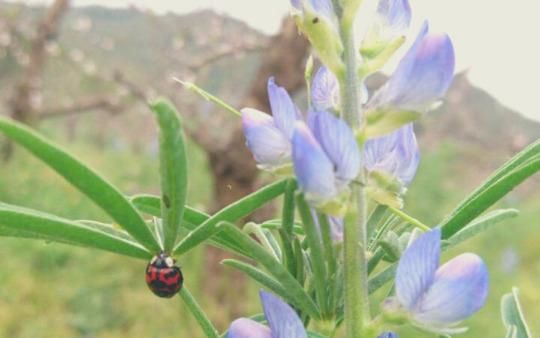
We’ve broadened our view from not using any chemical fertilisers, pesticides or fungicides, to also growing things in season, and supplying, as well as eating local. Try to imagine the calculated carbon footprint an out-of-season pepper has, not to mention all the chemicals probably used to grow it, and keep it looking fresh for your consumption. The shift of looking at what you eat and understanding how and where it comes from is important in realising and embracing the essence of organic produce.
Working towards the concept of natural farming. Plain and simply put, organic farming is a marketed version of natural farming, the version that “sells”. We firmly believe that organic produce should be accessible to the masses. At the moment however, it seems to be exclusively promoted to those labeled as “well off”, and the prices for produce are, to be quite frank, ridiculous. Okay yes, when growing things organically, there may be a chance of a lower yield due to pests and disease. But that is if you are trying to grow organically in a conventional setting, like monocropping, totally eliminating pests, using chemicals engineered for specific genetically modified plants, and the likes. And that’s just it – organic farming is not only about what you put into your plants, it’s about thinking out of the box and working with nature to find solutions to those pesky problems. In time you’ll find that those so-called pesky problems weren’t actually problems at all, but merely imbalances, that nature inevitably sorts out for you.
Environmentally speaking, growing organically supports, and can improve ecosystems. By not spraying harmful pesticides, one allows a space of abundance for beneficial, and yes, non-beneficial insects and organisms to thrive. In due time, a balance between your pests, those that eat or damage your potential harvest, and their predators, will form. By not applying fertilisers, plants are encouraged to form communication bonds with mycorrhiza in the soil, which allow the plants to get the precise nutrients they need, for all the deficiencies they could possibly get, and for them to connect with other surrounding plants to create mutually beneficial links. As a result, the growth of microorganisms boom, and soil health further improves. Because soil health improves, the water retention of the soil increases and thus less water is wasted. And you end up with happy plants in a thriving ecosystem.
I recently found out a fun fact: if an insect eats the leaves of a plant or if the plant is otherwise slightly damaged and survives, the fruit of the plant can contain an increased amount of antioxidants. This is an evolved reaction and defense mechanism, in order to prolong lifespan and the genes. How marvelously delightful – the nutritional value of produce literally increases if the plant is slightly damaged.
This leads me to consider that we should think about produce differently, and should change the way we look at food in general. We need to see it in a bigger picture, from soil, to seed, to farm, to environmental impact, to harvesting, to packaging, to transport, to public suppliers, to your table, and to the benefits it has on your body. Knowing where your produce is from is a start, knowing how it’s grown is the next step. Being happy with both answers means you are doing your part by living consciously.
For me, one of the beautiful things of organic farming is how truly unique the crops look. Every single vegetable and fruit is different in appearance; a knobble here, an indent there, a size and colour variation… and oh, how wonderful that is! I think we as consumers have to shift our idea of what produce looks like, smells like and tastes like. That perfectly round, deep red glossy apple, with little-to-no taste is overrated. Have you tried washing all that wax off? No thank you, not for me (please do try it – place an apple in a bowl of hot water and watch as the wax floats to the top). Often fruits or veg with slight insect bites or scratches from grazing the branch in the wind are perfectly wholesome and tasty. But somehow we as consumers have been made to believe that these are not good enough and should either be valued at a lower price or should not be bought at all. Man oh man, have we been missing out. If an insect has bitten it, you know it’s good to eat. It’s about looking towards nature for guidance.



There is something special about producing organic fruits and vegetables that lends itself to the creation of community. Not only connecting people to the communities of plants and the environment, but also connecting people to people, the sharing of learnt knowledge for no ulterior motive other than the purest form of helping. Commercial farming prioritises profit, and while generating an income from organic farming is also a need, it’s not necessarily the focus. The health of the ecosystem, soil and plants are at the core. So happily giving a neighbouring farmer some of your cover crop seed because you know it works well, or giving advice on how to plant a certain crop because you’ve done it successfully before, is not a problem because you don’t see each other as competitors, but rather brothers and sisters in farms.
Don’t get me wrong, going organic is not easy – it takes strong will power to push through the rough times. Like the times when all your freshly sprouted green beans are eaten by a tag-team of francolin and guinea fowl, or when the fruitflies find all of your watermelon just too darn tasty to resist. Patience and perseverance are key. Keep doing what you are doing, improve your soil by growing cover crops, plant a diverse variety of crops so you have some sort of back up in the meantime, and mulch, mulch, mulch. Keep on keeping on, in due time nature will play its part and bring about balance. The fruits of that labour are definitely worth it.
Being inspired by nature is possibly the key aspect of going organic. Working with plants you have sown, in soil you have nurtured and replenished, and interacting with their needs in such a way that you are an assistant helper and always a keen observer, just there to tend to needs not yet fulfilled by a balanced ecosystem. In due time you will become part of that balance.
Ultimately, we believe that farming organically is one step on the path towards feeding the world.
– Bushrah, one of those who harvest
#organic farming#organic agriculture#regenerative farming#regenerative agriculture#eat organic#go organic#why organic#farming#agriculture#permaculture#eat local#environmetalists#GMO free#sustainability#sustainable farming#harvest#those who harvest#ThoseWhoHarvest
6 notes
·
View notes


